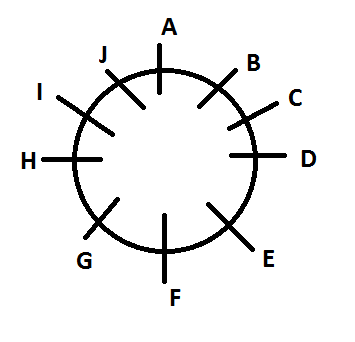Answer
359.7k+ views
Hint: First, we learn the meaning of the terms permutation and combination which are important topics in probability.
In Probability, the permutation is the process of arranging the outcomes in order. Here, the order must be followed to arrange the items.
In Probability, the term combination refers to the process of selecting the outcomes in which the order does not matter. Here, the order to arrange the items is not followed.
Formula used:
\[\text{Probability of an event} = \dfrac{\text{Number of outcomes}}{\text{Total number of outcomes}}\]
Complete step-by-step solution:
It is given that ten persons are sitting at the round table.

Here, the first person has the choice of choosing all seats, and the second person can choose the remaining nine seats. Similarly, the third can choose the remaining eight seats and it goes on. The last one has to choose the remaining last one seat.
That is the total number of ways in which $10$ persons can sit at a round table $ = \left( {10 - 1} \right)!$
$ = 9!$ways
First, we shall calculate the probability that two persons are adjacent to each other.
Let the two persons be A and B.
Then eight people are there.
The number of ways in which eight persons can sit together is $ = \left( {9 - 1} \right)!$
$ = 8!$ ways
Here A and B can interchange their seats in $2!$ ways.
The required number of ways will be $2! \times 8!$
The probability that two persons are adjacent to each other$ = \dfrac{\text{Number of outcomes}}{\text{Total number of outcomes}}$
$ = \dfrac{{2! \times 8!}}{{9!}}$
$
= \dfrac{{2! \times 8!}}{{9 \times 8!}} \\
= \dfrac{2}{9} $
Hence, the probability that two persons are not adjacent to each other $ = 1 - \dfrac{2}{9}$
$ = \dfrac{{9 - 2}}{9} \\
= \dfrac{7}{9} $
Therefore, the probability that two persons are not adjacent to each other is $\dfrac{7}{9}$. So, option (D) is correct.
Note: The formula to find the permutation is as follows.
\[{}_n{P_r} = n(n - 1)(n - 2).......(n - r + 1)\]
$ = \dfrac{{n!}}{{(n - r)!}}$ (! Is a mathematical symbol called the factorial)
Where $n$ denotes the number of objects from which the permutation is formed and $r$ denotes the number of objects used to form the permutation.
Now, the formula to calculate the combination is as follows.
${}_n{C_r} = \dfrac{{n!}}{{r!\left( {n - r} \right)!}}$
Where $n$ denotes the number of objects from which the combination is formed and $r$ denotes the number of objects used to form the combination.
In Probability, the permutation is the process of arranging the outcomes in order. Here, the order must be followed to arrange the items.
In Probability, the term combination refers to the process of selecting the outcomes in which the order does not matter. Here, the order to arrange the items is not followed.
Formula used:
\[\text{Probability of an event} = \dfrac{\text{Number of outcomes}}{\text{Total number of outcomes}}\]
Complete step-by-step solution:
It is given that ten persons are sitting at the round table.

Here, the first person has the choice of choosing all seats, and the second person can choose the remaining nine seats. Similarly, the third can choose the remaining eight seats and it goes on. The last one has to choose the remaining last one seat.
That is the total number of ways in which $10$ persons can sit at a round table $ = \left( {10 - 1} \right)!$
$ = 9!$ways
First, we shall calculate the probability that two persons are adjacent to each other.
Let the two persons be A and B.
Then eight people are there.
The number of ways in which eight persons can sit together is $ = \left( {9 - 1} \right)!$
$ = 8!$ ways
Here A and B can interchange their seats in $2!$ ways.
The required number of ways will be $2! \times 8!$
The probability that two persons are adjacent to each other$ = \dfrac{\text{Number of outcomes}}{\text{Total number of outcomes}}$
$ = \dfrac{{2! \times 8!}}{{9!}}$
$
= \dfrac{{2! \times 8!}}{{9 \times 8!}} \\
= \dfrac{2}{9} $
Hence, the probability that two persons are not adjacent to each other $ = 1 - \dfrac{2}{9}$
$ = \dfrac{{9 - 2}}{9} \\
= \dfrac{7}{9} $
Therefore, the probability that two persons are not adjacent to each other is $\dfrac{7}{9}$. So, option (D) is correct.
Note: The formula to find the permutation is as follows.
\[{}_n{P_r} = n(n - 1)(n - 2).......(n - r + 1)\]
$ = \dfrac{{n!}}{{(n - r)!}}$ (! Is a mathematical symbol called the factorial)
Where $n$ denotes the number of objects from which the permutation is formed and $r$ denotes the number of objects used to form the permutation.
Now, the formula to calculate the combination is as follows.
${}_n{C_r} = \dfrac{{n!}}{{r!\left( {n - r} \right)!}}$
Where $n$ denotes the number of objects from which the combination is formed and $r$ denotes the number of objects used to form the combination.
Recently Updated Pages
When people say No pun intended what does that mea class 8 english CBSE

Name the states which share their boundary with Indias class 9 social science CBSE

Give an account of the Northern Plains of India class 9 social science CBSE

Change the following sentences into negative and interrogative class 10 english CBSE

Advantages and disadvantages of science

10 examples of friction in our daily life

Trending doubts
Difference between Prokaryotic cell and Eukaryotic class 11 biology CBSE

Which are the Top 10 Largest Countries of the World?

Fill the blanks with the suitable prepositions 1 The class 9 english CBSE

Differentiate between homogeneous and heterogeneous class 12 chemistry CBSE

Difference Between Plant Cell and Animal Cell

10 examples of evaporation in daily life with explanations

Give 10 examples for herbs , shrubs , climbers , creepers

Write a letter to the principal requesting him to grant class 10 english CBSE

How do you graph the function fx 4x class 9 maths CBSE



